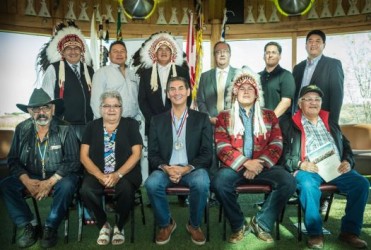Article Origin
Volume
Issue
Year
Turning entitled land into reserve land means the difference between bringing members home to the reserve and offering programs that are not funded through federal dollars.
“We need to ensure all lands we received are productive and ensuring there’s potential revenue coming back to our community for unfunded programs,” said Chief Marie-Anne Day Walker-Pelletier of the Okanese First Nation.
Day Walker-Pelletier was Chief in 1992 when Okanese First Nation, along with 24 other First Nations, signed the Treaty Land Entitlement Framework Agreement with then Prime Minister Brian Mulroney and former Premier Roy Romanow. The framework provided $445 million to the bands to acquire 1.5 million acres. If they met the criteria set out in the framework, those land acquisitions would then be converted to reserves. Since 1992, another eight First Nations signed similar agreements, bringing the value of the TLE settlement process to $595 million and two million acres.
But it’s not only about the 20 years that have passed since the TLE framework agreement was signed, says Day Walker-Pelletier, it’s what has been accomplished in that time.
For Okanese First Nation it has meant turning 10,000 acres of acquired lands into reserve land by 1999. It was a fairly fast process for the band.
“We tried to be as diligent,” Day Walker-Pelletier said, “to get the lands turned over as quickly as possible because land prices were going up and up so we tried to meet those deadlines also.”
But not all First Nations have experienced the same quick turn-around.
Over 800,000 acres have achieved reserve status to date, but another 400,000 acres remain at various stages of the federal and provincial approval process.
“We are concerned that hundreds of thousands of land selections remain stuck at various stages of the reserve creation process,” said Bobby Cameron, interim chief of the Federation of Saskatchewan Indian Nations.
“It’s not an easy process. It’s a complicated one,” said Al Hilton, provincial deputy minister of government relations, who also called the Saskatchewan process unique. “While it’s not working as quickly as perhaps some people would like, it’s certainly historic.”
Third party interests can present a complication when acquiring land, Day Walker-Pelletier says, and government approval can also drag out what is supposed to be an 18-month process.
The Okanese First Nations is in the process of working on 4,000 more acres of equity land.
“We hope to achieve that as land comes available and where it’s suitable, that’s still part of our planning,” Day Walker-Pelletier said.
The land Okanese First Nation has converted is agricultural. None of the band members are farming it. Instead, the acres have been leased out as pasture land and are generating much needed revenue. However, that income still represents not even 10 per cent of Okanese’s $4 million annual budget, says Day Walker-Pelletier. She is optimistic that as the First Nation develops its land base it will also be able to develop its minerals.
“Hopefully down the road the band can benefit from either potash or other minerals that are within our land,” she said.
Day Walker-Pelletier is also hopeful that newly acquired land will mean more of the 650 members will be able to move home.
The reserve presently has a population of 250 to 300 and has a waiting list for housing.
However, while more land will mean an opportunity to provide more housing, it doesn’t necessarily mean an opportunity to provide jobs. But Day Walker-Pelletier points out that if land acquired can be located near an urban centre, it will permit Okanese band members to live on reserve while working in a nearby town or city.
Having a substantial land base is imperative for First Nations survival, Cameron says. Land provides economic opportunity, which leads to employment, development and social infrastructure for First Nations, such as better housing, education, and social programs.
“There’s still a lot of work ahead of us,” he said.
The Lands & Resources Secretariat of the FSIN plans to bring federal and provincial officials together with the affected entitlement First Nations to review and implement measures to improve reserve creation results, says the FSIN in a news release.
The 20th anniversary ceremony was held at Wanuskewin Heritage Park, where the TLE Framework Agreement was signed in 1992.
- 2111 views

